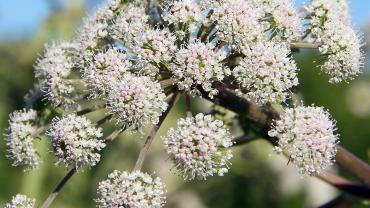
Tense, spasmodic muscles may contribute to back pain, headaches, and other conditions. Finding ways to help relax the muscles to reduce muscle spasms may help the chronic conditions associated with this type of pain. Many of these potential agents target different aspects of neurological and musculoskeletal systems, including acting as a gamma-aminobutyric acid (GABA) agonist. Herbs and botanicals may help support muscle relaxation and promote a normal pain response.* One such herb is valerian root, a popular herb for supporting restful sleep.*
Valerian root (genus Valeriana; commonly V. officinalis) has a long history of medicinal uses, especially for supporting sleep and anxiety. Valerian contains many bioactive compounds, including alkaloids, terpenes, valepotriates, and flavones. The most active compound is valerenic acid, which may have anxiolytic properties. Studies have also demonstrated the potential for valerian to have analgesic properties, likely by inhibiting nitric oxide synthesis (a hyperalgesia mediator).
Gamma-aminobutyric acid (GABA) is the major inhibitory neurotransmitter that controls a variety of different actions, including motor function, pain, sleep, brain development, and anxiety. GABA receptors are located in every region of the brain, and up to 40% of central nervous system synapses act on GABA. Valerian may affect the GABAergic system by modulating GABAA receptors. Upon activation, GABAA receptors have an inhibitory effect by hyperpolarizing neurons and reducing the chance of an action potential. This receptor is a common target for anxiolytic, analgesic, and sedative drugs such as benzodiazepines.
Agents that modulate this receptor may help support muscle relaxation and conditions associated with tense muscles, such as tension headaches.* A double-blind, randomized, clinical trial with 88 participants assessed taking 530 mg of valerian root extract compared with a placebo twice daily for a month for tension-type headaches. The valerian group experienced a significant reduction in the impact of headaches on daily living, reduction in disability, and the severity of tension-type headaches. The researchers postulated this may be due to the stress reduction of valerian, its effects on GABA, and its analgesic properties.
Valerian may also support a normal pain response that may also support conditions associated with tense muscles and musculoskeletal pain.* In an animal model of fibromyalgia, valerian (as Valeriana fauriei Briq.) supplementation led to a significant reduction in pain. This was likely through the downregulation of brain-derived neurotrophic factor (BDNF) and phosphorylated cyclic adenosine monophosphate response element-binding protein (CREB). The BDNF pathway may be involved in neuropathic pain and neurotransmitter activity, including serotonin and dopamine.
As indicated, valerian may have additional benefits beyond supporting restful sleep,* as its effects on the GABAergic system show promise to help support muscle relaxation and a normal pain response.* However, more research is necessary to determine specific recommendations of its effects on the musculoskeletal and neurological systems.
By Kendra Whitmire, MS, CNS